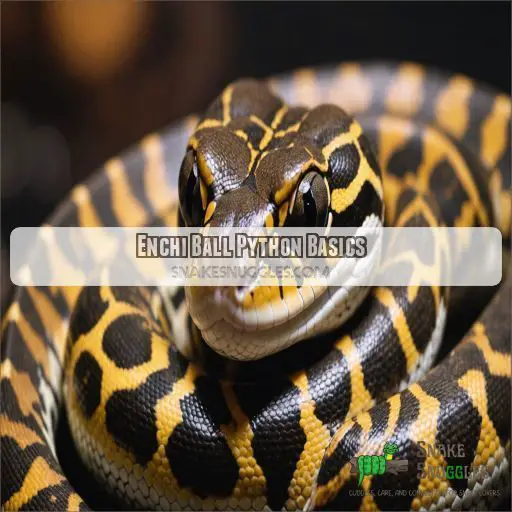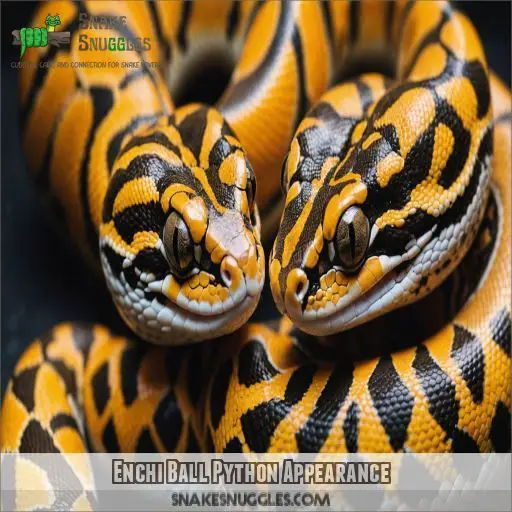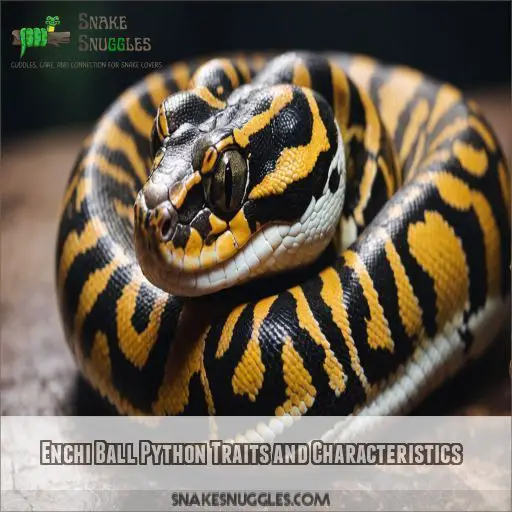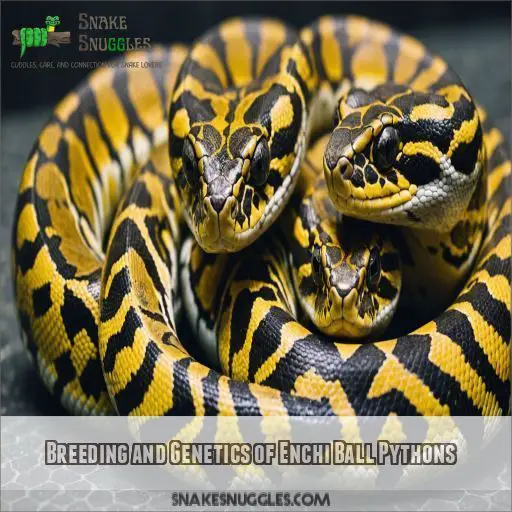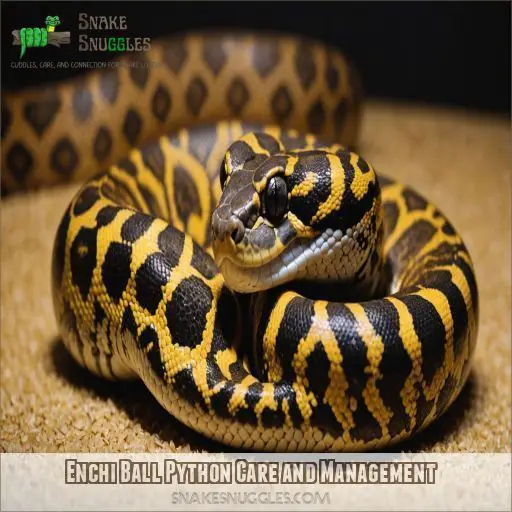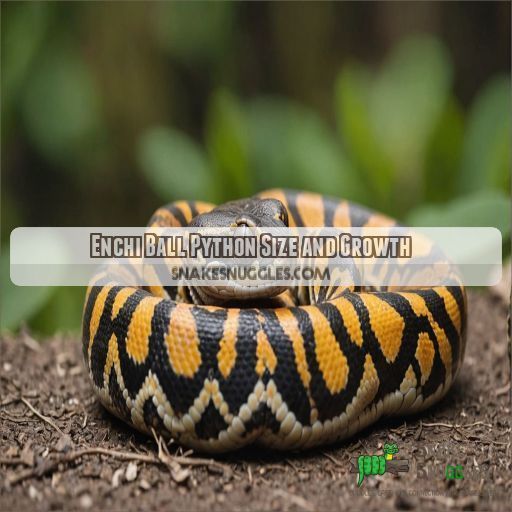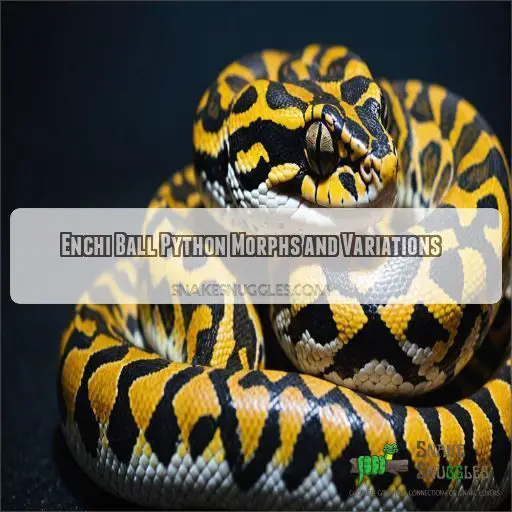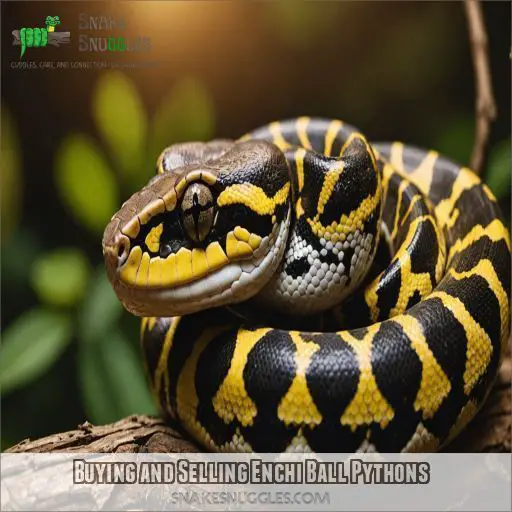This site is supported by our readers. We may earn a commission, at no cost to you, if you purchase through links.
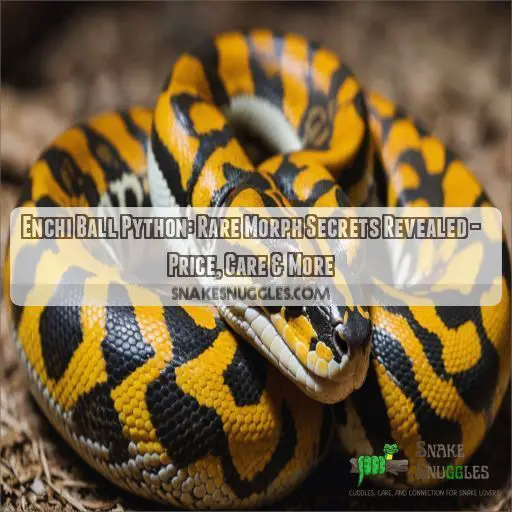
This serpent boasts a unique copper-bronze coloration and a mesmerizing pattern that’ll leave you captivated.
With its golden-yellow sides, chocolate-like dark pigmentation, and copper-bronze hues, the Enchi Ball Python is a true showstopper.
But what makes it so special?
For starters, its incomplete dominant gene expression means it can be expressed in both homozygous and heterozygous forms.
Want to know more about this breathtaking creature and how to care for it?
You’re in for a treat!
Table Of Contents
- Key Takeaways
- Enchi Ball Python Basics
- Enchi Ball Python Appearance
- Enchi Ball Python Traits and Characteristics
- Breeding and Genetics of Enchi Ball Pythons
- Enchi Ball Python Care and Management
- Enchi Ball Python Size and Growth
- Enchi Ball Python Morphs and Variations
- Buying and Selling Enchi Ball Pythons
- Enchi Ball Python Health and Disease
- Frequently Asked Questions (FAQs)
- What is an Enchi ball python?
- How to tell if your ball python is enchi?
- Is Enchi a spider morph?
- What to breed an enchi ball python?
- How does the Enchi gene interact with other Ball Python genes?
- Can Enchi Ball Pythons be used to create new morph combinations?
- What are the differences between Enchi and Super Enchi Ball Pythons?
- How does the Enchi gene affect the pattern and coloration of offspring?
- Are Enchi Ball Pythons more prone to certain health issues than other morphs?
- Conclusion
Key Takeaways
- You’ll know you’ve got an Enchi Ball Python by its striking golden-yellow sides, chocolate-brown markings, and copper-hued "alien head" pattern – and these colors will only get more vibrant as your snake grows.
- The Enchi Gene is an incomplete dominant, meaning it can be expressed in both homozygous and heterozygous forms, and it will interact with other genes to create truly one-of-a-kind combinations – so get ready to geek out on Ball Python genetics.
- Breeding Enchi Ball Pythons requires careful consideration of genetic possibilities, and you’ll want to pair your Enchi with a compatible morph to create stunning combinations – but don’t worry, with a little research and planning, you can unlock new and exciting patterns and colors.
- As an Enchi Ball Python owner, you’ll need to be on the lookout for common health issues like respiratory infections, shedding problems, parasites, and dietary issues – but with regular vet visits, proper care, and a healthy dose of enthusiasm, you can keep your Enchi happy and thriving.
Enchi Ball Python Basics
As you explore the fascinating world of Ball Pythons, you’ll discover the Enchi morph is a unique and striking color pattern that enhances the snake’s orange hues and side patterns. In this section, you’ll learn the basics of Enchi Ball Pythons, including their history, classification, and conservation status, giving you a solid foundation to appreciate these incredible reptiles.
What is an Enchi Ball Python?
You’re about to get into the fascinating world of Enchi Ball Pythons! An Enchi Ball Python’s price can vary greatly due to factors such as genetic mutation value. An Enchi Ball Python is a rare morph that’s sure to captivate any snake enthusiast. With its unique genetic makeup, this morph subtly increases orange coloration and bright side patterns. Here are 4 key characteristics that’ll make you fall in love with Enchi Ball Pythons:
- Vibrant coloration: Enchis display stunning golden-yellow sides and chocolate-like dark pigmentation.
- Incomplete dominant gene: The Enchi gene can be expressed in both homozygous and heterozygous forms.
- Alien heads pattern: Enchis have a unique copper/bronze coloration in their alien heads pattern.
- Reduced pattern: The Enchi’s pattern is greatly reduced, with alien heads becoming flat and featureless.
History and Discovery of Enchi Ball Pythons
You’re probably curious about where the Enchi Ball Python came from. Well, let’s explore its fascinating history! The Enchi morph was first discovered in 1998 in a shipment of juvenile Ball Pythons from Ghana, Africa. Early breeding programs were established, and the genetic impact of this morph on the Python regius species has been significant.
Enchi Ball Python Classification and Conservation
You’re curious about the Enchi Ball Python‘s classification and conservation status. As a Ball Python morph, Enchis belong to the Pythonidae family, with the scientific name Python regius. Unfortunately, Ball Pythons are listed as Near Threatened due to habitat loss, hunting, and climate change. Conservation efforts are underway to protect their habitats in Sub-Saharan Africa.
Enchi Ball Python Appearance
You’re probably curious about what makes the Enchi Ball Python so visually stunning, and the answer lies in its unique color morph and pattern characteristics. As you explore the Enchi’s appearance, you’ll discover how its colors change with age, transforming into a breathtaking display of oranges, yellows, and golden hues.
Enchi Ball Python Color Morph
You’re now familiar with the basics of Enchi Ball Pythons, so let’s get colorful! The Enchi Ball Python color morph is a stunning variation, showcasing golden-yellow sides, chocolate-like dark pigmentation, and copper-bronze hues. This genetic influence creates a unique visual appeal, making Enchi morph combinations highly sought after among reptile enthusiasts and breeders alike.
Enchi Ball Python Pattern Characteristics
You’re probably curious about the Enchi Ball Python’s pattern characteristics. This morph’s pattern is quite unique, with a few distinct features:
- Reduced pattern: The Enchi’s pattern is greatly reduced, with alien heads becoming flat and featureless.
- Golden sides: The Enchi’s sides are a beautiful golden-yellow color.
- Copper-bronze alien heads: The alien heads pattern has a stunning copper-bronze coloration.
Changes in Color With Age
As your Enchi Ball Python grows, you’ll notice its color morph changing. The golden-yellow sides and chocolate-like dark pigmentation will become more vibrant with age. Here’s a rough idea of what to expect:
| Age | Color Phase |
|---|---|
| Juvenile (0-12 months) | Muted, washed-out colors |
| Sub-adult (1-2 years) | Colors start to intensify, patterns emerge |
| Adult (2+ years) | Full, vibrant coloration with defined patterns |
Enchi Ball Python Traits and Characteristics
As you explore the fascinating world of Enchi Ball Pythons, you’ll discover that their unique traits and characteristics set them apart from other morphs. From their distinctive head shape and pattern to their striking tail and body coloration, let’s break down what makes these snakes so interesting.
Head Shape and Pattern
If you’re looking at the Enchi Ball Python’s head shape and pattern, you’ll notice a distinctive look. The Enchi’s head closely resembles a Normal Ball Python’s head, but with a few key differences. Here are three things to look for:
- A heavily blushed crown with brighter yellows through the eye stripes
- A subtle pattern variation that sets it apart from other morphs
- A slightly smaller head size compared to other Ball Pythons
Tail Pattern and Characteristics
Now that we’ve explored the Enchi’s head shape and pattern, let’s talk tail! The Enchi’s tail is quite the showstopper, typically ending with a thick stripe or beading pattern, similar to a Normal Ball Python, but with that gorgeous golden coloration. You’ll notice the tail beading is more pronounced, adding to the Enchi’s unique charm.
Body Coloration and Pattern
Now that we’ve explored the tail pattern and characteristics of Enchi Ball Pythons, let’s talk about their stunning body coloration and pattern. You’ll notice a beautiful golden-yellow color with a subtle orange glow, accompanied by a reduced pattern with alien heads becoming flat and featureless. This unique color variation is due to the Enchi gene’s incomplete dominant expression.
Breeding and Genetics of Enchi Ball Pythons
You’re about to uncover the secrets of breeding Enchi Ball Pythons.
It’s going to be a wild ride of genetic combinations and exciting possibilities.
In this section, we’ll break down the incomplete dominant gene expression of Enchi Ball Pythons.
We’ll also explore the best practices for breeding them.
And finally, we’ll reveal some of the most stunning morph combinations that will make your heart skip a beat.
Incomplete Dominant Gene Expression
If you’re curious about Enchi Ball Python genetics, you’ll want to grasp the basics of incomplete dominant gene expression.
This means that even if your Enchi Ball Python only has one copy of the gene, it’ll still display the characteristic golden-yellow sides and copper-tinged alien heads pattern.
In simple terms, the Enchi gene can be expressed in both heterozygous and homozygous forms.
Breeding Enchi Ball Pythons
You’re ready to get into Enchi Ball Python breeding. As an aspiring breeder, you want to master the art of producing stunning Enchis. Here are some key considerations:
- Start with high-quality, genetically diverse parents.
- Understand Enchi genetics and incomplete dominant gene expression.
- Breed for desirable traits, not just color.
- Prioritize ethical breeding practices and animal welfare.
- Keep accurate records to refine your breeding strategy.
Enchi Ball Python Morph Combinations
Now that you’ve got a handle on breeding Enchi Ball Pythons, let’s talk about creating stunning morph combinations! By pairing Enchis with other morphs, you can create unique patterns and colors. Popular Enchi combos include Aquila, Baja, and Frostbite, each offering a distinct visual appeal and breeding value. Mix and match to discover your new favorite morph!
Enchi Ball Python Care and Management
You’re about to bring home your very own Enchi Ball Python – now it’s time to learn how to give it the best life possible. In this section, you’ll discover the essential care and management tips to keep your Enchi happy and thriving, from habitat and environment requirements to diet and feeding needs, and key health considerations.
Habitat and Environment Requirements
- Enclosure size: Aim for a spacious 20-30 gallon tank.
- Temperature gradient: Provide a warm spot (85-90°F) and a cooler area (75-80°F).
- Humidity control: Keep it between 50-60% with a hygrometer.
- Hiding spots: Add rocks, plants, and logs for your snake to curl up in.
Diet and Feeding Requirements
When feeding your Enchi Ball Python, control is key. Establish a routine feeding schedule, with prey size increasing as your snake grows. Provide a varied diet rich in nutrients, including mice, rats, and occasionally, quail or chicks. Aim for 1-2 times a week for juveniles, and less frequently for adults, to keep them happy and healthy.
Health and Wellness Considerations
Now that you’ve got your Enchi Ball Python’s diet down, let’s talk health and wellness. Keep an eye out for signs of stress, like changes in appetite or shedding patterns. Regular check-ups can help prevent issues like parasites, calcium deficiency, and respiratory infections. Good husbandry practices are key to a long, happy life for your Enchi.
Enchi Ball Python Size and Growth
As you explore the fascinating world of Enchi Ball Pythons, understanding their size and growth is important for providing proper care and ensuring their overall health. Let’s take a closer look at the average length and weight, growth rate, and factors that affect the size and growth of these stunning snakes.
Average Length and Weight
Typically, Enchi Ball Pythons reach an average length of 5-6 feet and weigh around 3-5 pounds. However, some Enchis can grow larger, so you should keep an eye on their growth chart. Factors like diet, habitat, and genetics can affect their adult size. Keep in mind that every Enchi is unique, and their size and weight range can vary.
Growth Rate and Development
Your Enchi Ball Python’s growth rate is a thrilling journey, and it’s fascinating to see how quickly they grow during their first year! As your pet grows, you’ll notice significant changes. Here are four key growth stages:
- Hatchling (0-6 months): Newborns are about 10-12 inches long and weigh 4-6 grams.
- Juvenile (6-12 months): They grow to 20-30 inches and 20-50 grams.
- Sub-adult (1-2 years): Reaching 3-4 feet and 100-200 grams.
- Adult (2-5 years): Your Enchi will finally reach its full size, up to 5-6 feet and 3-4 pounds.
Factors Affecting Size and Growth
As you nurture your Enchi Ball Python, you’ll want to know what factors affect its size and growth. Genetics play a significant role, but diet, environment, and stress levels also impact its development. A balanced diet, proper humidity, and a stress-free habitat will support healthy growth. Regular veterinary check-ups will also help identify any potential health issues.
Enchi Ball Python Morphs and Variations
You’re about to enter the fascinating world of Enchi Ball Python morphs and variations, where subtle genetic tweaks can create stunning, one-of-a-kind patterns. From the intense, vibrant hues of Super Enchi Ball Pythons to the softer, pastel tones of Pastel Enchi Ball Pythons, you’ll discover the unique characteristics that make each morph a prized addition to any Ball Python collection.
Super Enchi Ball Pythons
Now that you’ve got a handle on the size and growth of Enchi Ball Pythons, let’s talk about the ultimate variant: the Super Enchi.
With its intense, vibrant coloration, this morph is a breeder’s dream.
But what makes it so special?
Breeding values and color variations are key, and genetic testing can confirm authenticity, impacting price trends and Super Enchi care.
Pastel Enchi Ball Pythons
Now that you’ve fallen for the stunning Super Enchi, let’s talk about its softer cousin – the Pastel Enchi Ball Python. Imagine a gentle, serene version of the Enchi, with a subtle pastel glow. To bring out this morph’s full beauty, focus on precise Pastel Enchi care, including a balanced diet and ideal humidity. Your reward? A breathtaking, one-of-a-kind companion.
Banana Enchi Ball Pythons
You’re ready to learn about Banana Enchi Ball Pythons! This rare morph is a game-changer for enthusiasts. Here’s what you need to know:
- Unique coloration: A beautiful blend of yellow and orange hues.
- Genetics: A combination of the Enchi and Banana genes.
- Care: Similar to other Ball Pythons, with a focus on humidity and temperature control.
- Pricing: Expect to pay a premium for this rare morph.
Buying and Selling Enchi Ball Pythons
As you consider bringing an Enchi Ball Python into your life, it’s important to know how to buy and sell these stunning creatures with confidence. By understanding how to find reputable breeders, make informed purchasing decisions, and evaluate pricing and value considerations, you’ll be well on your way to welcoming a healthy, thriving Enchi Ball Python into your home.
Finding Reputable Breeders
Now that you’ve fallen in love with the various Enchi Ball Python morphs, it’s time to find a reputable breeder. Research breeder ethics, read reviews, and check for certifications. Look for local breeders or online resources like Ball Python breeders. Don’t be afraid to ask questions – a good breeder will be happy to share their expertise with you.
Purchasing Enchi Ball Pythons
Now that you’ve found a reputable breeder, it’s time to bring your Enchi Ball Python home! When purchasing, make sure the snake has undergone health checks and is well-cared for. Talk to the breeder about enclosure needs to make the move smooth. Remember, buying from a responsible breeder supports ethical sourcing and the well-being of these amazing creatures.
Pricing and Value Considerations
When buying an Enchi Ball Python, pricing and value considerations come into play. You’ll want to research the market, considering factors like breeder reputation, morph impact, and demand. Prices can fluctuate, but expect to pay between $100 to $250 for a standard Enchi. Rare combos, like the Uranium Blast, can fetch higher prices due to their unique characteristics and limited availability.
Enchi Ball Python Health and Disease
As you bring home your new Enchi Ball Python, you’re probably wondering what health issues to watch out for and how to keep your pet happy and thriving.
You’ll want to know how to prevent and treat diseases.
You’ll also want to find the right veterinary care and connect with experienced breeders and enthusiasts.
Common Health Issues in Enchi Ball Pythons
Now that you’ve brought your Enchi Ball Python home, it’s time to think about health. As a responsible owner, you want to know what to watch out for. Here are 4 common health issues to keep an eye on:
- Respiratory infections: Listen for wheezing or labored breathing.
- Shedding problems: Check for stuck sheds or scales.
- Parasites: Look for mites, ticks, or internal worms.
- Dietary issues: Monitor for regurgitation or weight loss.
Disease Prevention and Treatment
To keep your Enchi Ball Python healthy, focus on parasite prevention and sound husbandry practices. Regular vet visits and quarantine procedures can help prevent common illnesses. Here’s a quick rundown of disease prevention and treatment:
| Prevention | Treatment | Quarantine |
|---|---|---|
| Clean enclosure | Antibiotics | Isolate new snakes |
| Provide fresh water | Antiparasitic meds | Monitor for symptoms |
| Balanced diet | Supportive care | 30-day quarantine |
Veterinary Care and Consultation
Now that you’ve got a handle on disease prevention and treatment, let’s talk about finding the right doc for your Enchi Ball Python.
Regular vet visits are really important to prevent and detect health issues early on.
Look for an exotic vet with experience in reptile care.
Don’t hesitate to ask about their approach to preventative care and parasite treatment.
Enchi Ball Python Breeders and Enthusiasts
When diving into Enchi Ball Pythons, you’ll meet a passionate community of breeders and enthusiasts. Many great breeders prioritize ethical Enchi breeding, ensuring these stunning snakes thrive. Connecting with the Enchi community helps you stay updated on best Enchi care practices, fair Enchi prices, and upcoming breeding projects, giving you a sense of control and understanding.
Frequently Asked Questions (FAQs)
What is an Enchi ball python?
Imagine owning a serpent with mesmerizing orange and yellow hues! As you learn about ball pythons, you’ll discover the Enchi, a morph that intensifies these colors, creating a truly breathtaking sight.
How to tell if your ball python is enchi?
Check if your ball python’s got those telltale Enchi signs: golden-yellow sides, chocolate-brown markings, and a copper-hued ‘alien head’ pattern. If its colors get more vibrant with age, that’s a strong Enchi hint!
Is Enchi a spider morph?
You’re wondering if Enchi is a spider morph? Not quite! While Enchi Ball Pythons can be combined with spider morphs to create stunning combos, Enchi itself is a unique color and pattern morph that adds a golden touch.
What to breed an enchi ball python?
Want to breed an Enchi Ball Python? Pair it with a compatible morph like a Normal, Lesser, or Pastel to create stunning combinations. Research the genetic possibilities and choose a mate that complements its unique traits.
How does the Enchi gene interact with other Ball Python genes?
You’re about to get a grip on the ultimate Ball Python genetic puzzle! The Enchi gene is an incomplete dominant, meaning it can be expressed in both homozygous and heterozygous forms, interacting with other genes to create stunning, one-of-a-kind combinations.
Can Enchi Ball Pythons be used to create new morph combinations?
You can definitely experiment with Enchi Ball Pythons to create stunning new morph combinations. With their unique genetic traits, they can be paired with other morphs to produce exciting patterns and colors, so get creative and discover new possibilities!
What are the differences between Enchi and Super Enchi Ball Pythons?
You’re about to uncover the differences between Enchi and Super Enchi Ball Pythons! Think of Enchi as a warm-up act, while Super Enchi takes center stage with amplified orange hues, richer colors, and an unmistakable wow factor.
How does the Enchi gene affect the pattern and coloration of offspring?
When you breed Enchi Ball Pythons, the Enchi gene enhances orange coloration and brightens side patterns in offspring, producing golden-yellow sides, chocolate-like dark pigmentation, and copper/bronze hues in the alien heads pattern – a stunning visual effect!
Are Enchi Ball Pythons more prone to certain health issues than other morphs?
You’re right to wonder about potential health issues in Enchi Ball Pythons. While generally a healthy morph, some Enchi combinations can be more prone to genetic disorders like wobble syndrome (Source).
Conclusion
Did you know that only 1% of Ball Pythons in captivity are Enchi morphs?
You’re now part of an exclusive club, having fallen in love with the stunning Enchi Ball Python!
With its unique copper-bronze coloration and mesmerizing pattern, it’s no wonder this serpent has captured your heart.

